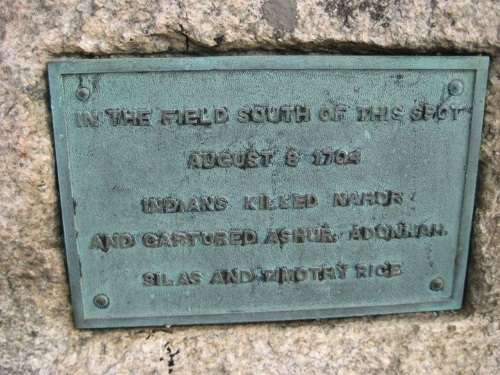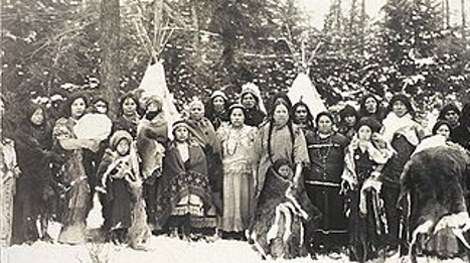On a hot August day in 1704, the Rice boys were working with their fathers to spread flax in a field in what is now Westborough, Mass. Suddenly a party of about 10 Indians rushed down from the wooded hill nearby and seized five of the Rice boys.
The Indians bashed 5-year-old Nahor Rice’s brains out on a rock. They carried off four others, aged 7 to 10, while everyone else escaped to the garrison house of Thomas Rice.
Queen Anne’s War had broken out, one of the French and Indian wars fought over domination of North America. During the war, French and Indians raided frontier towns in New England. Six months before Indians captured the Rice boys, the raid on Deerfield, Mass., left 47 dead and 112 captured. The Indians marched the captives through the snow to Canada.
The Rice boys mirrored the fate of the Deerfield captives. Some were ransomed, or redeemed, through the efforts of their families and Dutch traders. Others, like 7-year-old Eunice Williams, assimilated with the Indians and refused to return to their homes.
The Thomas Rice Boys
Asher Rice, 10, and his brother Adonijah, 8, were sons of Thomas Rice.
Silas, 9, and Timothy, 7, were the sons of Edmund Rice, a second cousin of Thomas Rice.
The Indians took the Rice boys to Kahnawake territory, a mission in Canada where the Jesuits had converted the Iroquois to Catholicism.
The Rice family tried desperately to redeem their boys. They enlisted the help of a Col. Lydius, a Dutch merchant in Albany.
Thomas sold his home to pay for his sons’ ransom. Asher, the oldest, had the hardest time assimilating with the Indians. Four years after his capture, Asher returned home, ‘so broken by the shock he had received at the time of his seizure that he never fully recovered from it.’
He developed eccentricities. Wrote Westborough historian Herman Packard De Forest,
“He spent a great deal of effort in making a gristmill on a new plan, so that the upper stone should be fixed, while the lower one revolved. This, he insisted, was the only natural way, for in the human mouth, which was evidently the original corn-mill, it was the lower jaw that did the work.”
Asher Rice retained some of the habits he picked up during his four years in captivity, but he dreaded the return of the Indians. Throughout his life he built stockades, long after the danger had passed. His father built him a house in 1720, and he married and had a son.
His brother Adonijah was never redeemed, but he did leave the Indians at some point. Adonijah was given the Indian name Asaundugooton. He married a French woman, then a Dutch woman, and owned a farm near Montreal.
The Edmund Rice Boys
Silas and Timothy grew up with the Indians and completely forgot how to speak English. Their father tried to redeem the boys, traveling to Canada in 1707. He met with no success. The boys preferred to stay with their Indian families.
Edmund Rice died in 1726, the same year he wrote a will that said, “if Almighty Power should work that deliverance for my two sons Silas and Timothy out of their captivity, which we indeed of ourselves can have little prospect of, and bring them home, they shall receive five pounds each.”
Timothy was adopted by a Kahnawake chief who had been converted to Catholicism.
Rev. Ebenezer Parkman, a Westborough minister, recorded Timothy’s history in 1769.
“Timothy had much recommended himself to the Indians by his own superior talents; his penetration, courage, strength & warlike spirit; for which he was much celebrated,” wrote Parkman.
His name was Oughtzorongoughton.
Return Home
The youngest of the Rice boys, Timothy, became a Kahnawake clan chief and married an Indian woman, Catherine Osennenhawe. They had at least one son, named Pierre.
Eventually, in 1740, Timothy returned to his home in Westborough with an interpreter, a Mr. Tarbell, another colonist captured by Indians from Groton, Mass.
“They arrived here Sept. 15th. They view’d the house where Mr. Rice dwelt, & the Place from whence the children above spoke of, were captivated; of both which he retained a clear Remembrance; as he did likewise of Several elderly persons who were then living,” wrote DeForest.
Massachusetts Gov. Jonathan Belcher sent for Tarbell and Rice, and they visited him in Boston.
Later when the American Revolution broke out, Timothy was said to be influential in keeping the Indians from joining the English during the American Revolution. He died at the age of 80 in 1777.
Silas Rice married an Indian girl named Marie Tsiakohawi; he took the name Jacques Tannahorens. They had five children. A granddaughter married the grandson of Eunice Williams.
According to one source, in 1900 Silas had at least 1,350 descendants, a large portion of all the Iroquois in Canada and the United States.
This story about the Rice boys was updated in 2023. The image of the historic marker: By Innapoy – I took this photo, CC BY 3.0, https://en.wikipedia.org/w/index.php?curid=28895668





6 comments
My ancestor Elizabeth Howe of Marlborough Massachusetts shares a similar history. While visiting her sister in Lancaster she witnessed her sister, Mrs. Sarah Joslyn, and her children’s murder by Indians before her eyes. She was captured and held in Canada for four years then was redeemed but never recovered from the trauma of those events. It’s said that she was spared because she could sing and entertain the Indians also that she retained a lot of the customs of the Indians. Through this blood line is my third great grandfather Moses Fisk born 1760 in Grafton, MA. He was a staunch abolitionist and was concerned with the welfare of American Indians. Upon his graduation from Dartmouth College he moved to the Overton County area of Tennessee credited with surveying much of the Upper Cumberland area prior to it being recognized by the State as a county. It is said that his wife Nancy Fisk (Schultz) was half Cherokee. I haven’t found any other history on her or anything to validate the claim. Just wondering if there is anything someone can contribute to the history story here…
[…] Four Rice Boys Captured by Native Americans in 1704; Three Rice Boys Decide To Stay […]
[…] In 1704 the Mohawk and Abenaki Indians were allied with the French against England during Queen Anne’s War. […]
I think the statment “the chose to stay” might be incorrect. The methods that the Iroquois and Mohawk used to bring a member into the tribe was pretty sadistic. Clearly these young children were severely traumatized by their incident. Seeing their youngest relatives head-smashed-in then having to deal with the trauma of their ordeal did not leave them in a state of willingly choosing to stay.
I think studying the methods used by the tribes is helpful to understand what the prisoners went through.
https://www.ohio.edu/orgs/glass/vol/1/14.htm
.
Hi Adam,
I would just like to point out that the Rice boys were not prisoners of war, they were captives meant to bolster the Mohawk population.
After reading Mr. Scheimann’s paper, one might assume torture and gauntlet was the only method of adoption. It was not.
I don’t think the Rice boys were tortured.
Were they traumatized? Perhaps yes, they certainly went through a terrifying experience. However, some people go through tough experiences very well, others not so much.
I would also like to point out the context of the times; when most of north america’s non-Native population lived puritan lives, most Natives lived in a different, perhaps freer type of lifestyle. Relatives of the captors “who chose to stay” could simply not accept this choice (especially the father of Eunice Williams, taken during the Deerfield raid who is said to have died of a broken heart).
This disbelief, in my opinion, continues today as a result of misunderstanding and historical context.
Anyway, thats only my 2c…
Clearly the stories of the one rice boy who was brought back to Massachusetts indicates they did suffer severe trauma. Remember these are the same chapter who smashed the five-year-old’s head in probably in front of the other children. The Mohawks in Iroquois had a very elaborate process of bringing captives into their tribe. It involves a lot of torture for days. It was a very emotional event.
Most native North American tribes had a long history of slavery, torture, rape and colonization of each other’s territory. It’s not uncommon nor anything to criticize today. It’s just the way things were. But to write an article that tries to make it seems as if these young children made a conscious Choice without external pressures is delusional and dishonest. People need to learn about the thousands of years of horrific Savage torture and abuse genocide Mass rape Etc by the nation’s first people. It was part of their history and history has to be told the way it was not the way we want it to be.
Remember that the word Mohawk translate to Maneater. They were cannibals.
Comments are closed.